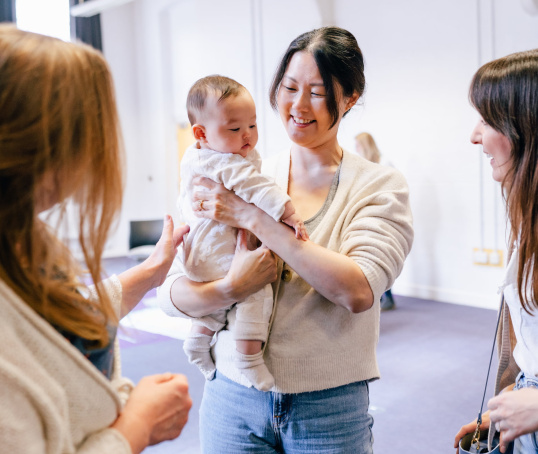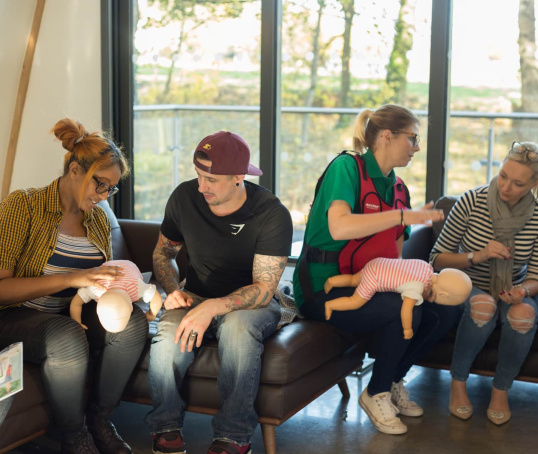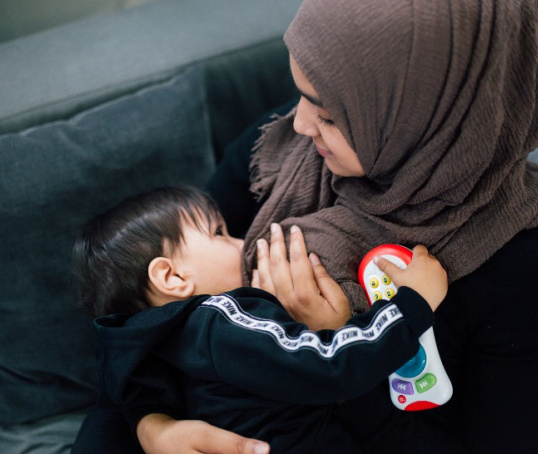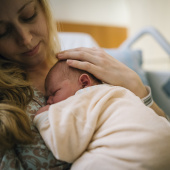Baby massage is a lovely way to enjoy time with your baby and it can also help you bond with them. Find out more in this article.
Before babies are able to understand language, we often communicate and comfort them through touch. If a baby cries, for example, parents will hold, cuddle or stroke them. Baby massage is part of this natural impulse.
Find out about the benefits of baby massage for you and your baby in this video.
What is baby massage?
Baby massage is the gentle, rhythmic stroking of your baby's body using your hands. As part of a massage routine, you might gently manipulate your baby's ankles, wrists and fingers.
"You might also talk softly, hum or sing to them while massaging to create a sense of calm and reassurance for your baby".
What are the benefits of baby massage?
Baby massage was introduced about 30 years ago in neonatal wards to support the development of premature babies in intensive care units. A study in 2004 found that babies in intensive care units who were massaged spent less time in hospital, had slightly better scores on developmental tests and slightly fewer postnatal complications.
Today, there is widespread belief that baby massage can increase a mum’s awareness of her baby’s needs and support their early bond, as well as improve her sense of well-being if she is suffering with postnatal depression or other mental health issues. The evidence is inconclusive on these points but parents do say they find baby massage a lovely way of bonding with their baby.
Many talk about the following benefits:
- Becoming more confident in handling their child and better at recognising their needs.
- Improved positive interaction with their baby.
- A great way for partners, family members and carers to bond with baby.
- Improved sleep for their baby.
When can I start baby massage?
There are no set guidelines regarding the minimum age for when to start baby massage. Although nurturing touch can be given from birth, some babies may find formal, structured massage too stimulating in the very early weeks.
When it comes to baby massage classes, some babies may find a formal class overwhelming in the early weeks. It can also be hard for parents to make it to a class on time or consistently with a newborn. As a result, many parents prefer to wait until their baby is about six weeks old when their routine is more settled and their behaviour is sometimes more predictable.
"It can also be helpful to start baby massage after your baby’s six week check so any issues with development, such as hip dysplasia, might be identified".
Getting ready to massage your baby
Here are some tips to help you try baby massage at home:
- Choose a time when your baby is content and alert, not tired or hungry, and interested in what’s going on around them. This makes it more likely that they’ll be ready to interact with you.
- Try sitting on the floor, bed or sofa, with your baby safely on a towel in front of you.
- Find a position that’s comfortable, gives you good eye contact with no overhead lights and where your baby is warm.
- It's up to you whether your child is nappy-free, but it can help to at least loosen their nappy when massaging the tummy.
- It can be a nice idea to introduce a massage after bath and before bed as part of a bedtime wind-down.
How to give your baby a massage
Before beginning 'ask permission' by rubbing a little oil between your hands near your baby’s ears, and ask 'can I give you a massage?' This may sound a little strange but your child will become familiar with this cue and know that massage is about to start. It also gives your baby a chance to let you know if they don’t feel like a massage.
It's great to massage the whole of your child's body using a range of techniques. To get you started, we describe some strokes below for the legs and feet.
- Once you have 'asked permission’, gently hold one of your baby's legs between your palms.
- Then, with one hand, hold your baby's ankle securely. Mould your other hand around the top of your child's thigh, then slide it down the leg towards the ankle.
- Swap hands and repeat. Always keep your child's ankle supported and use slow, flowing strokes.
- Next, cradle your child's foot in your hands and use your thumbs to stroke over the sole of the foot from heel to toes, one thumb after another. Hold your fingers in a tripod grip and gently tug each toe between thumb and finger.
- Holding your child's foot in your hands, walk the thumbs across the middle third of the foot from one side to the other like a little caterpillar crawling on a leaf.
- You could also do circles on the palms of their hands singing ‘Round and round the garden like a teddy bear’. Continue with finger and thumb tugs.
- Finish by repeating the stroking action in the opposite direction, i.e. from ankle to thigh.
- You can repeat each stroke a few times, always responding to what your child seems to enjoy.
What oils/products should I use for baby massage?
While using oil can make massage easier for parents and more relaxing for their baby, there is limited evidence on what oil is best to use for baby massage.
Most research into the use of oils on a baby’s skin has not focussed on their use for baby massage but for skincare issues, such as dry skin or eczema. This is important to note because there may be a difference in the effect of using oils in baby massage once a week compared to every day for skincare reasons or for more frequent massage.
The NHS also recommends parents do not use any oils or lotions until their baby is one month old. This is because at birth, the top layer of a baby's skin is very thin and easily damaged. Over the first month (or longer in premature babies), a baby's skin matures and develops its own natural protective barrier.
Here is a list of oils and what is know about them:
- Cold-pressed oil - while there is a lack of evidence on its benefits, some parents prefer to use a cold pressed oil, which is manufactured differently to cooking oils and has fewer impurities.
- Mineral oils or petroleum-based ointments are an option if your baby has dry or broken skin, as they have been found to be effective and safe for treating skin problems, such as dermatitis and eczema.
- Mustard oil can have a toxic effect on the skin barrier, causing irritation and potential damage to delicate baby skin.
- Olive oil is not recommended for baby massage because of its high oleic acid content. This can make some layers of a baby's skin dryer.
- Other oils, such as grapeseed oil or coconut oil – these have not been effectively tested in research trials so there isn’t much information about their effectiveness or risks.
- Peanut oil contains proteins that may sensitise a baby to an allergic reaction to peanuts or cause a reaction on a baby's skin.
- Sunflower oil is often recommended for baby massage but recent research has suggested it might have adverse effects on a baby’s later skin barrier function. This was only a small trial though and more research is needed to establish the exact risk.
- Vegetable oils high in polyunsaturated fats may be gentler on your baby's skin.
Safety tips for baby massage
Here are some tips to help you massage your baby safely:
• Make sure you use oil that is safe for your baby’s skin and if it was to get into their mouth (see list above).
• When massaging your child's arms or legs, always support the ankle or wrist with one hand.
• When massaging your child's tummy with a circular motion, go clockwise rather than anti-clockwise.
• If your child becomes upset or falls asleep, stop massaging.
Enjoy baby massage
If your baby doesn't seem to enjoy massage right away, don't worry. It's a new experience for you both and it can take a bit of getting used to. Try a few minutes the first time and build up as your child gets more used to it.
This page was last reviewed in November 2017.
Further information
Our support line offers practical and emotional support with feeding your baby and general enquiries for parents, members and volunteers: 0300 330 0700.
Why not try one of our NCT Mother and Baby Yoga courses or baby massage classes?





